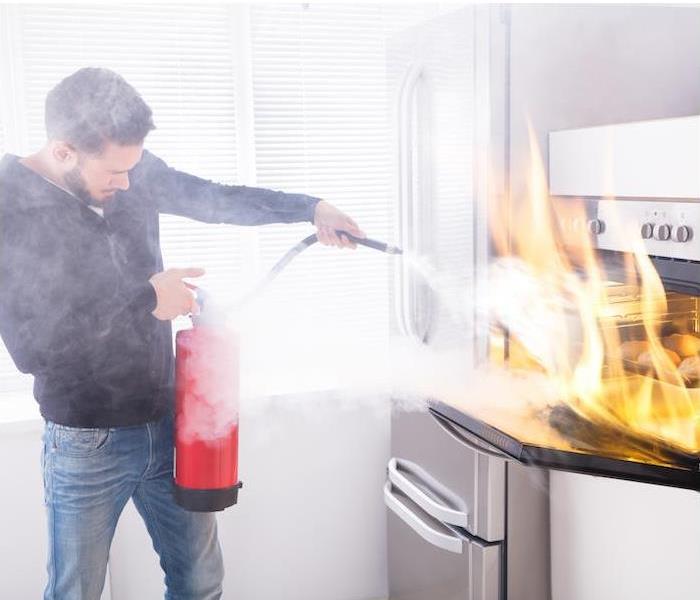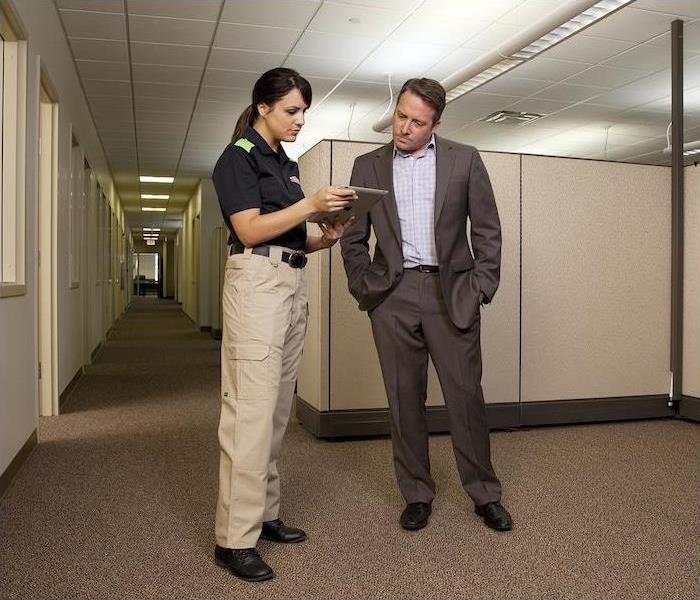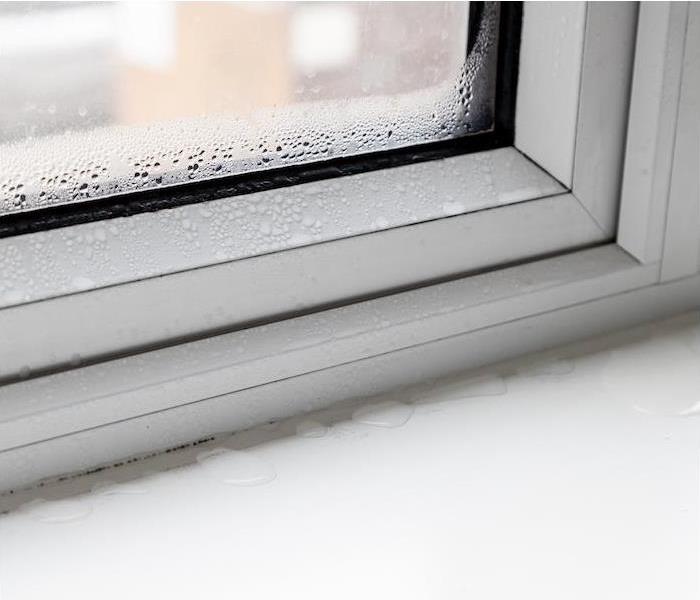You Can Prevent Fires in the Kitchen | SERVPRO® of San Juan
4/29/2024 (Permalink)
Even though the kitchen can be a wonderfully versatile place where family and friends gather to catch up or enjoy preparing and eating a meal together, it is also a place where many home fires occur.
Cooking fires are the No. 1 cause of home fires and injuries. The leading cause of these kitchen fires is unattended cooking.
State Farm paid out a whopping $130 million for homeowners insurance claims related to grease and other cooking fires in 2017. According to the insurance company, these are the worst states for kitchen fires:
- North Carolina
- Texas
- Pennsylvania
- California
- Ohio
- Illinois
- Maryland
- New York
- Alabama
- Georgia
Avoiding Fire Hazards in the KitchenStaying in the kitchen while cooking is not the only fire safety precaution you should observe. Take a look at these other helpful tips to observe while cooking:
1. What type of clothing are you wearing? Does your outfit have long, flowing sleeves or is it big and baggy? It could catch on fire if you aren’t careful while cooking over the stove. It’s best to wear short or close-fitted sleeve shirts and make sure any baggy shirts are tucked in or tied back.
2. What type of items are you placing around or on the stovetop? Make sure you don’t have kitchen towels, oven mitts, appliance cords or even curtains too close to the stovetop when cooking. Ideally, anything flammable will be moved away from it.
3. Do you have a fire extinguisher in/near the kitchen. Hopefully you have at least one fire extinguisher located in your home, ideally one that is near your kitchen. Make sure you know how to properly use the extinguisher, just in case it is ever needed.
4. How are you disposing of hot grease? While the grease may not be on fire, it could be hot enough to cause something in the trash to burn. You should let the grease cool a bit and then dispose of it in an old coffee can. Also, know the smoke points of the oils you cook with. Be sure to never subject a low-smoke point oil to high heat when cooking, as it could catch fire.
5. Do you have a fire escape plan established? Thinking about the worst-case scenario is never fun, but it’s better to be prepared than unprepared if an emergency were to occur. Go over exit routes and designated meeting points with your family, making sure that everyone knows what to do.
Fire safety in the kitchen is an absolute necessity, as it can help prevent dangerous and destructive cooking fires. If your home has experienced damage from a cooking fire, know that SERVPRO® of San Juan is here to make it “Like it never even happened.”
When a Disaster Strikes Your Business | SERVPRO® of San Juan
4/2/2024 (Permalink)
Any kind of disaster can leave you feeling completely overwhelmed and wondering where to go next. In an instant, everything at home, your community and your business can be changed for the worse.
Getting your life put back together at home is essential, but for a small business owner, so is getting work going again. By creating a plan ahead of time and having a team like ours at SERVPRO of East Brownsville & South Padre Island right around the corner, you can get back to business as usual quickly.
Prepare Ahead of TimeThe best way to ensure a fast recovery after any kind of disaster strikes is by having an emergency plan. When you and your employees know how to respond before, during and after an event occurs, you can keep your business moving forward.
One of the most crucial parts of an emergency plan is communication. Your staff need to know each step of the process in order to make things run smoothly. Make emergency planning part of your regular training in order to keep everyone on the same page.
Regularly walk through your building, and ensure emergency routes are clear. Show your staff where the main water shut-off valve is and where fire extinguishers are located throughout your building. Assign staff members different actions to complete ahead of predicted disasters in order to prepare your building as much as possible.
After a disaster strikes, your employees need to know how work will start back. If working remotely is the plan, ensure secured networks are up and running. If you will be utilizing an alternate location, make sure everyone knows where and when to report for their duties.
Communicate with your team in multiple ways, and keep in mind that some disasters may take out networks long-term. Make sure everyone on staff can send and receive text messages as these are one of the more reliable ways to get in touch when coverage is spotty.
Recover QuicklyWhen you have a plan, you can rest a little easier knowing that everything has been done to protect your building and your staff. Make sure that contacting SERVPRO® is first on your to-do list as soon as the threat is over so that restoration can begin right away.
Our professional team can respond day or night to your physical location in order to start the rebuilding process, which means you can start communicating with your customers right away. Let them know a projected reopening date and how you will continue to serve them. Use multiple platforms to provide updates throughout your recovery process as well. Be transparent with your community in order to stay as engaged as possible with your customers.
Keep in mind that disaster recovery is a multilayered process that doesn’t happen overnight. Be flexible in how you keep work going, and shift your priorities as needed. With an open mind, you will push through any kind of disaster, and things will be back to normal that much faster.
Create and practice an emergency plan with your staff regularly, and make sure you have multiple ways to communicate with both your team and your community. No matter what happens, we can rebuild your physical location while you keep work going.
Has your business experienced a disaster, or do you want help building an emergency plan? Contact us to find everything you need.
Moisture and Your Home | SERVPRO® of San Juan
4/2/2024 (Permalink)
We use water a lot in our daily lives. From running the dishwasher to putting in what feels like the 15th load of laundry for the day, having water the moment we need it is a pretty big blessing. While it is a blessing, when water gets into the wrong places, it can turn our homes on end and create total chaos.
When you know where to look for leaks, you can take fast action to stop them. There are several places that leaks can commonly hide out around your home, but with a little regular maintenance you can keep water exactly where it is supposed to be.
Under Your SinksYour sinks, toilets and bathtubs are all prime places for water leaks to hide. With so many different water lines under each of your sinks and so much water already around, it can be hard to catch small problems before they become a big issue.
When leaks start under your sink, they can quickly affect your cabinets, walls or even the floor. Look under the sinks once a week. Feel the water lines for excess moisture, and tighten the connectors. Replace any seals that have worn out, and dry up any drips you see.
Beneath AppliancesOur appliances really make our lives convenient, but until something goes wrong, we don’t often think about the amount of water that goes in and out of them each time they run. Dishwashers, water heaters, washing machines and refrigerators are all prone to leaks that are often hard to find.
Pull these appliances away from the wall every few months and give the space behind them a good cleaning. Check for puddles, drips or other moisture on the wall or floor. Mold, musty smells or soft spots in the floor are other indicators that something is leaking somewhere in the appliances lines.
Behind Your Walls or FloorsHidden leaks can be particularly dangerous because they can seep into every nook and cranny near them. This often leads to water damage behind your walls and under your floor. Even when you find a leak fast, water may have gotten into the wrong places.
Never ignore a musty smell especially when it is near a water-based appliance. A new squeak in the floor can be another indicator that something is going wrong. Do some investigating so that you can correct issues fast.
Around Your Windows and DoorsCondensation on your windows can be common, particularly when the temperatures are fluctuating. It can be easy to ignore this as something that will go away on its own, but it can actually lead to damage around the structure of your home as the water trickles down into cracks or between your siding.
Check your window seals and around the frames of your windows regularly by feeling for moisture. Feel around your door seals as well. The seasonal change is the perfect time to refresh the seals around your home and keep everything tight.
If you do find water damage in your home, don’t let it cause you to panic. Call SERVPRO® for fast and complete restoration. We have the crew and equipment to get your home dry after a major flood or a little leak that got out of control. Whatever you need, we have your needs covered.
Don’t ignore signs of water damage! Call SERVPRO for a quick restoration.

 24/7 Emergency Service
24/7 Emergency Service


